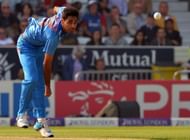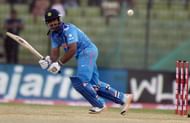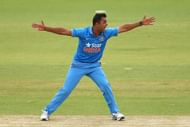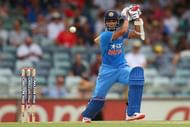While the world is busy speculating over the marvels of the Ashes series, Indian cricket season is currently at a serene, calming phase before the eventual storm of competitive cricket in the upcoming months leading to the T20 World Cup.With most of thepermanent squad members opting to rest, a young and inexperienced side was sent to compete with Zimbabwe, in hopes of shining some light on promising stalwarts that would usher forth a positive era for India cricket, which is currently rife with rumours of political unrest.Here are few things that went in Indias favour, and few that didnt.
#1 Positive: Return of Bhuvneshwar Kumar & Harbhajan Singh

One of the biggest gains from the series would be the pleasing sight of Bhuvneshwar Kumar returning to his swinging, miserly ways. With MS Dhoni’s snide hint at India’s reluctance to continue the fast bowler project, the return to potency for India’s current top swing bowler is good news for everyone. While Kumar picked up wickets, it’s his return to economical bowling (albeit, aided by the new cricket rules) that truly signals he has vanquished the demons of that fateful injury that made him lose his skillset.
Apart from that, his death bowling has also seen a massive improvement. Kumar was a regular death bowler for Sunrisers Hyderabad in the IPL, and his growing tendency to bowl yorkers at the rear end of the innings is gradually making him a fully accomplished bowler. The 50th over of the 1st ODI, in which he successfully defended India’s total against Elton Chigumbura’s resilience will give him a massive boost.
Equally gratifying was the return of Harbhajan Singh, who continued to show he is just as canny as always. While he was bowling to a relatively weaker batting opposition, his consistency and experience was once again at display and he might just claim his spot back in the Indian team in place of Ravindra Jadeja.
#2 Negative: No team players

With a few spots in the national team at stake, it was understood that every youngster wished to make a statement by racking up decent scores. This however led to a stagnation in the team’s momentum, and unneeded slowing of the scoring rate at several times in this series. While they were playing on a slow Harare pitch against a bowling attack that showed sparks of brilliance, many players put their individual scores ahead of the team’s desired target.
They were lucky that the bowling attack made up for these errors on several occasions, or set players successfully capitalised on their starts, because India were found struggling quite often in this series.
Why every player played for himself was understandable, yet the national team deserves players that will happily adapt to the situation and team’s requirements, and not many displayed that flexibility.
#3 Positive: Ambati Rayudu & Stuart Binny

MS Dhoni’s pet projects lived up to his faith in their talents by clearly outshining their counterparts in this series. Ambati Rayudu was at his fluent best before he got injured, and showed that he was a top contender for a middle-order spot in the Indian team. Stuart Binny showed a certain level of confidence that was hitherto unseen, batting with a bravado that Ravindra Jadeja once exhibited, and bowling with a knack to leak runs yet pick up some handy wickets.
While much of the confusion remains the same in the original XI, with Rayudu and Binny reclaiming their spots as contenders, the extra ounce of confidence that each player would have gained from this series would definitely affect their performances in future, and consequently result in something beneficial for Team India.
#4 Negative: Ajinkya Rahane

Hear me out on this one, before you gleefully jump the hate bandwagon.
Coming into this series, Ajinkya Rahane was supposed to fight back the claims ‘tends to struggle on slow pitches in ODIs’. He has never been doubted as a skilled, promising Test player for the ages. The question was never about his skill, temperament or technique. On many occasions in ODIs however, he has managed to stall momentum and increase pressure on other players. Recent, biting examples would be the World Cup semi-final against Australia or the Bangladesh series last month.
This led to him being dropped from the ODI side, and critics would expect he would do everything in his power to show he could play ODIs just as fluently as Tests. However, in a surprising move, he stubbornly stuck to his strategy in Tests, which led to slow starts which often didn’t convert into big scores.
It’s understandable that the pitch was slow and batsmen need time to settle, but anyone who actually watched the matches would agree his approach was excessively defensive and cautious, and strike-rate extremely ordinary for someone out to prove a point.
Rahane went into this series as one of the most experienced players, and one of the few regulars in the first-choice squad. However, he displayed none of that experience in his batting, and was found struggling on many occasions against a Zimbabwean bowling attack.
His captaincy however, was decent for a first-timer, and it’s unfortunate he’s currently in a team with captains like MS Dhoni and Virat Kohli.
Follow IPL Auction 2025 Live Updates, News & Biddings at Sportskeeda. Get the fastest updates on Mega-Auction and cricket news
